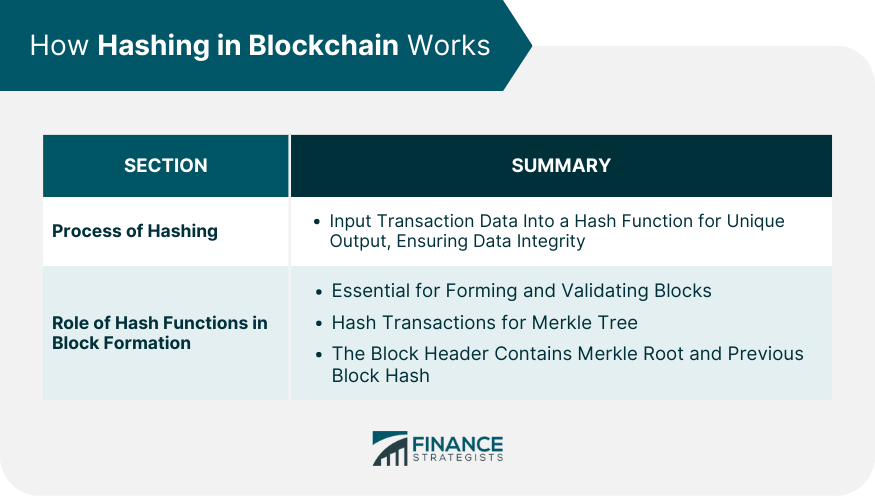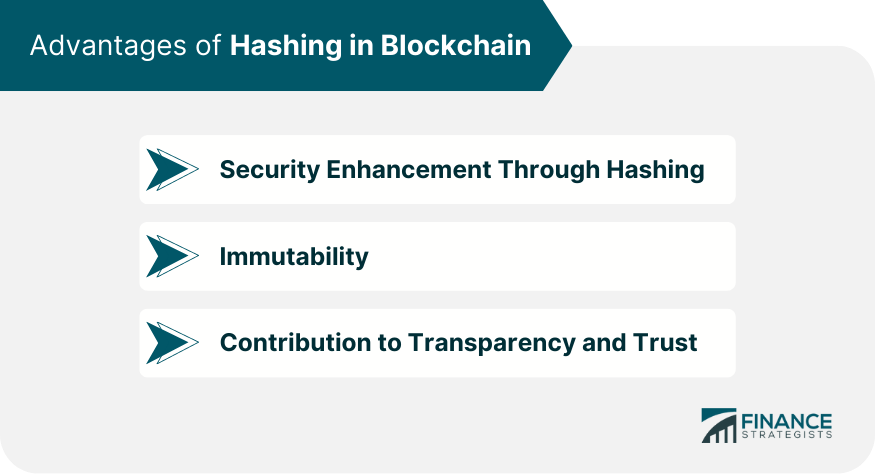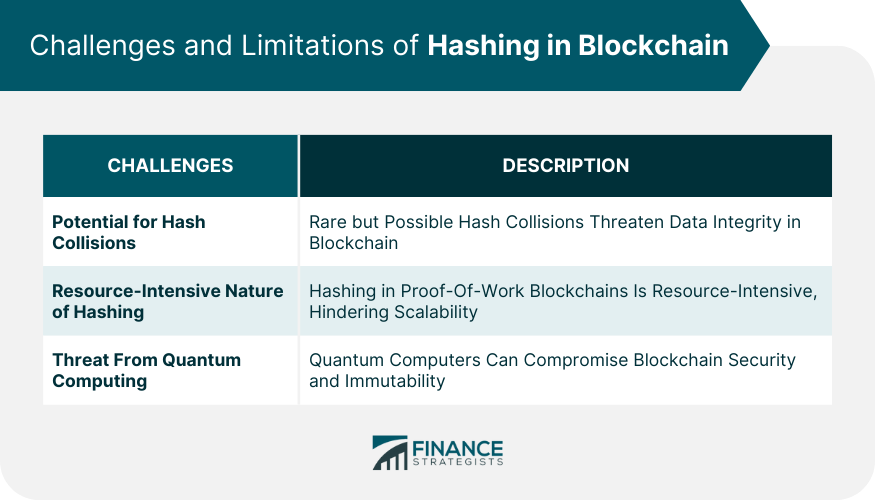In the realm of blockchain technology, hashing is a critical component that guarantees the integrity of data stored within each block. Hashing is a process where input data of any length is processed by a hash function to produce a fixed-size string of characters, typically a hexadecimal number. The produced hash serves as a unique identifier for the corresponding data. Hashing plays a critical role in maintaining the integrity of blockchain data. A slight modification in the data leads to a completely different hash output, making it almost impossible to manipulate the stored information without notice. Thus, hashing is essential for the immutability of the blockchain. In blockchain, whenever a transaction occurs, that transaction's data is taken as input to the hash function, which then produces a unique output. Each block in the blockchain carries the hash of the previous block, forming a chain of blocks (hence the term "blockchain"). If someone tries to alter the data in a block, the hash of that block changes, breaking the link to the following block and making the manipulation evident. Hash functions are crucial in forming and validating blocks in the blockchain. Each block consists of multiple transactions, and each transaction is represented by its hash. The hash of all transactions within a block is taken together to form the Merkle tree, whose root, known as the Merkle root, is stored in the block header. Additionally, the block header contains the hash of the previous block, creating a chain of blocks. In the domain of cryptocurrencies, particularly Bitcoin, the role of hashing extends far beyond merely creating a secure, unique digital fingerprint for data. It acts as the powerhouse for the generation of new coins and the validation of transactions. This process, known as mining, involves miners solving complex mathematical problems through hash functions. The puzzle's intricacy requires significant computational effort, making it a race where only the quickest and most efficient miner gets rewarded. On solving these problems, the winning miner earns the right to add the newly minted block to the blockchain, and as a token of appreciation for their work, they receive a handsome reward in the form of bitcoins. The integral role of hashing in this mining process makes it the cornerstone of cryptocurrency functionality. Smart contracts, one of the most innovative applications of blockchain technology, also rely heavily on hashing. These self-executing contracts, with the terms of the agreement directly written into code, depend on hashing to maintain their immutability. Once the contract's conditions are embedded into the blockchain, the hash function ensures that they remain unalterable. Moreover, hashing provides an extra layer of privacy. Instead of storing the contract details in an easily readable plain text format, they are hashed into a unique digital identifier. This measure maintains the integrity of the contract and prevents unauthorized viewing or alteration, fortifying the security and privacy of smart contracts. Hashing is a vital tool for maintaining consistency in distributed ledger systems, which form the backbone of blockchain networks. These systems operate on the principle of distributing copies of the ledger to all nodes within the network, which ensures decentralization and redundancy. Here, hashing helps maintain ledger synchronization across the entire network. If an alteration occurs in a single ledger copy, the resulting hash change makes the discrepancy immediately noticeable. Other nodes in the network can detect this change and reject the altered copy, ensuring that all ledger copies remain consistent and accurate. The role of hashing in preserving data consistency and synchronization in distributed ledger systems underlines its significance in upholding the blockchain's foundational principles. Hash functions contribute significantly to the security of blockchain. Given that the same input always results in the same hash and different inputs produce different hashes, it's nearly impossible to reproduce the original data from the hash (pre-image resistance). Furthermore, it is highly unlikely that two different inputs will result in the same hash (collision resistance), providing robust security against data tampering. The immutability of a blockchain is largely attributed to its use of hash functions. Since each block's hash depends on its content and the previous block's hash, changing information within a block would not only alter its own hash but also require alterations in every subsequent block's hash, a feat practically unachievable given the computational power required. In a blockchain, each transaction and block can be verified independently by its hash. This transparency allows anyone to verify the integrity of transactions or blocks without needing access to the actual data, fostering trust among participants in the network. Although extremely rare, hash collisions (when two different inputs produce the same hash) can theoretically occur due to the finite length of hash outputs. While current cryptographic hash functions used in blockchains, like SHA-256, make collisions incredibly unlikely, the possibility still exists, posing a potential threat to data integrity. Hashing, particularly in proof-of-work blockchain systems like Bitcoin, can be resource-intensive, requiring significant computational power. This resource requirement can lead to high energy consumption and be a barrier to blockchain scalability. Advanced quantum computers might be capable of reverse-engineering the hash functions, potentially compromising the security and immutability of the blockchain. Hashing in the blockchain is an essential mechanism ensuring data integrity, security, and immutability. It employs hash functions to transform transaction data into a unique, fixed-length string of characters, thereby creating a tamper-evident chain of blocks. Its significance extends to cryptocurrency mining, the implementation of smart contracts, and the synchronization of distributed ledger systems. Despite its substantial advantages, challenges such as potential hash collisions, resource-intensive nature, and future threats from quantum computing need consideration. However, with the hash-based structure enabling transparency and trust, it continues to be an integral part of the blockchain technology's robustness against manipulation, marking its pivotal role in the blockchain's promise of decentralization and security.What Is Hashing in Blockchain?
How Hashing in Blockchain Works
Process of Hashing
Role of Hash Functions in Block Formation

Role of Hashing in Various Blockchain Applications
Cryptocurrency Transactions and Mining
Smart Contracts
Influence on Consistency in Distributed Ledger Systems

Advantages of Hashing in Blockchain
Security Enhancement Through Hashing
Role of Hashing in Ensuring Immutability
Contribution to Transparency and Trust

Challenges and Limitations of Hashing in Blockchain
Potential for Hash Collisions
Resource-Intensive Nature of Hashing
Threat From Quantum Computing

The Bottom Line
Hashing in Blockchain FAQs
Hashing in the blockchain is a process where input data is transformed into a fixed-size string of characters by a hash function. It guarantees the integrity and immutability of data stored in each block of the blockchain.
Hashing enhances blockchain security by making it nearly impossible to reproduce the original data from the hash (pre-image resistance) and extremely unlikely that two different inputs will result in the same hash (collision resistance). These properties provide robust security against data tampering.
Each transaction within a block is represented by its hash. The hashes of all transactions are used to form a Merkle tree, and the root of this tree, the Merkle root, is stored in the block header. The block header also includes the hash of the previous block, forming the chain of blocks in the blockchain.
Challenges include the potential for hash collisions (although extremely rare), the resource intensity of hashing, particularly in proof-of-work systems, and the theoretical threat posed by quantum computing, which might eventually be capable of reverse-engineering the cryptographic hash functions.
Hashing is fundamental in cryptocurrency mining and transaction verification. In smart contracts, it ensures contract terms remain unaltered once deployed. In distributed ledger systems, hashing allows for synchronization and consistency of ledger copies across all network nodes.
True Tamplin is a published author, public speaker, CEO of UpDigital, and founder of Finance Strategists.
True is a Certified Educator in Personal Finance (CEPF®), author of The Handy Financial Ratios Guide, a member of the Society for Advancing Business Editing and Writing, contributes to his financial education site, Finance Strategists, and has spoken to various financial communities such as the CFA Institute, as well as university students like his Alma mater, Biola University, where he received a bachelor of science in business and data analytics.
To learn more about True, visit his personal website or view his author profiles on Amazon, Nasdaq and Forbes.











